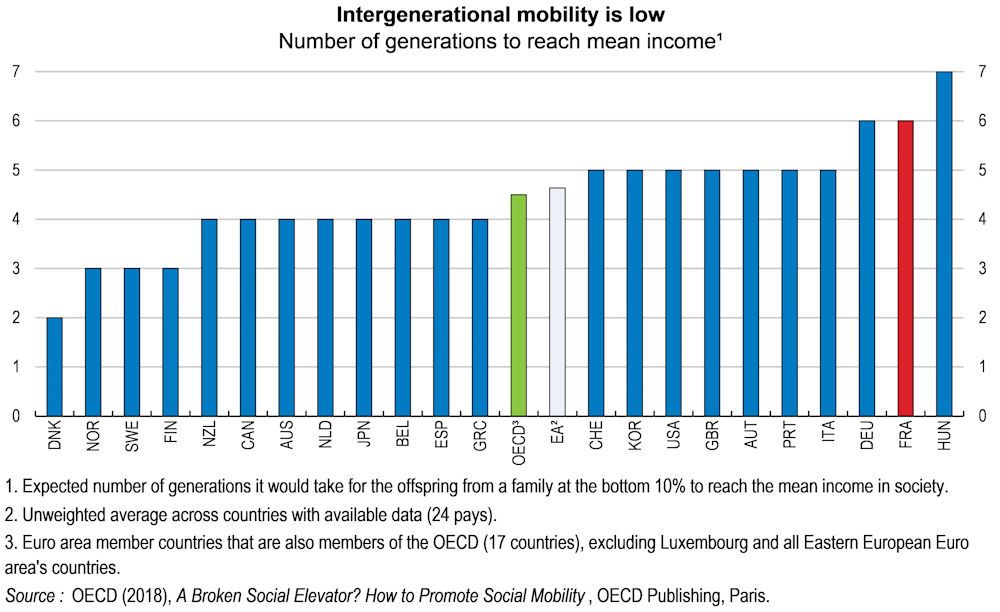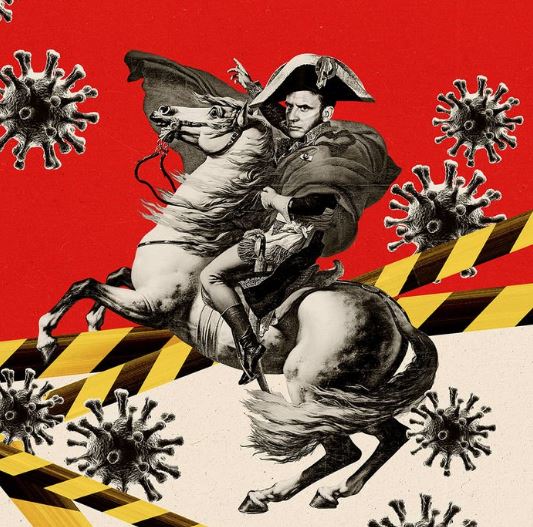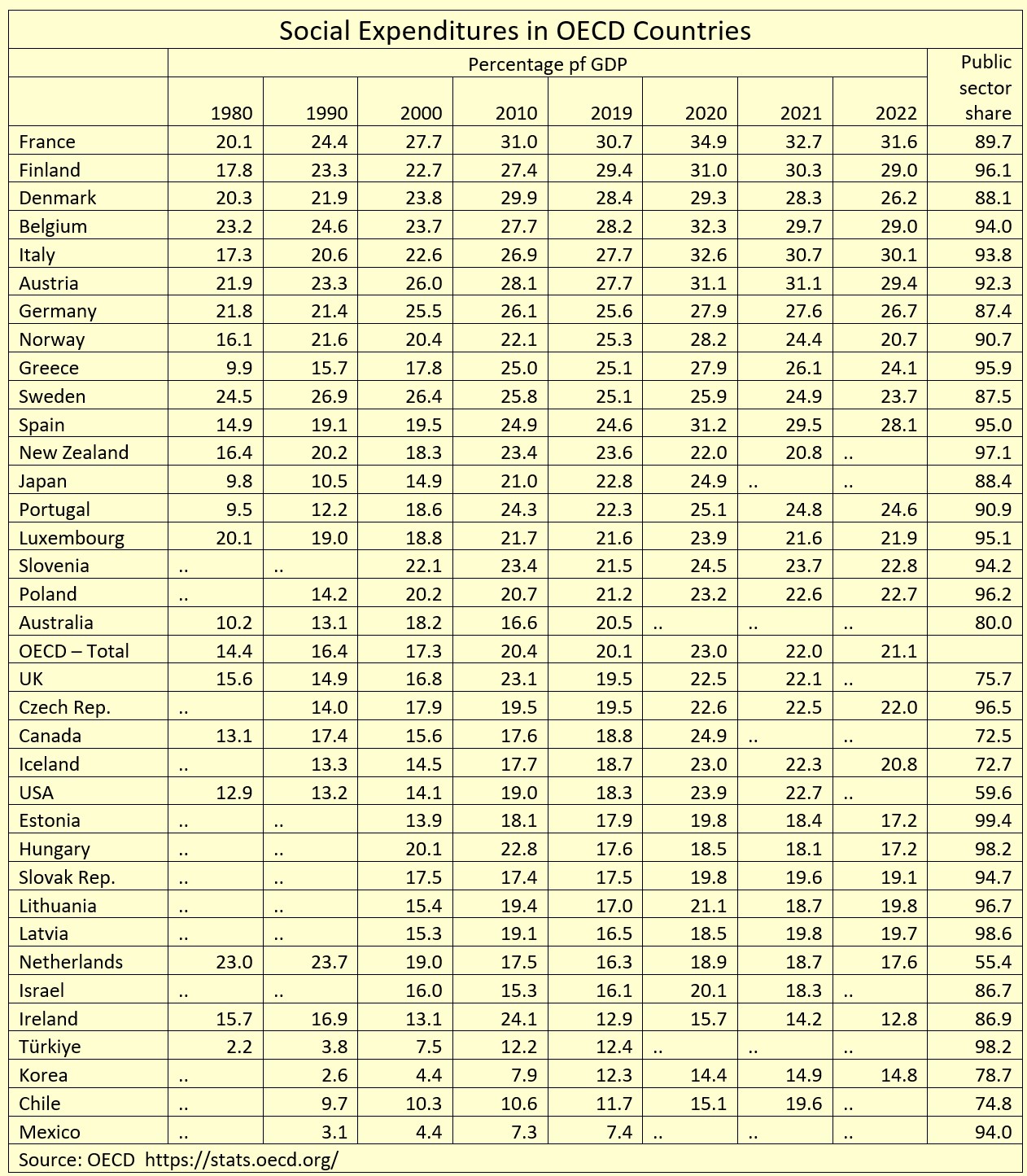|
France: Planning in the Market Economy
I.
The Environment
A. Conflict
of ideologies: "laissez
faire, laissez passer" and "liberté,
égalité, fraternité" versus Colbertism
(form of mercantilism),
Bonapartism (military
dictatorship), Gaullism (nationalism and
state intervention in framework of private enterprise), étatisme (state authority), dirigisme (direction,
interventionism), and elitisme.
B.
Deep Historic Class Divisions - Bred chronic
political instability and invited authoritarian central
government. Even though France now has one of the highest
levels of expenditures on income redistribution in the world
(see at end of this outline), it also has one of the lowest
levels of social mobility. It takes 6 generations for a person
born into the lowest 10% to reach median income. Rooted in
social discrimination and disparities in access to the better
schools, housing, and jobs. . See
more here

C.
Authoritarianism tempered by:
1.
Rule of law. Code Napoléon, enacted in 1804-1810, based on
relatively strict adherence to rules.
2.
Professionalism of the bureaucracy. Elite educational
institutions.
The Economist quipped that the French response to
COVID-19 was "Napoleonic":
" The day after lockdown was announced, the central
bureaucracy had, naturellement, drawn up a new form, which
each individual must sign to justify any trip out of the
home. Policemen and gendarmes, patrolling the near-empty
streets, parks and beaches, have since carried out a
staggering 5.8m checks on such paperwork and imposed
359,000 fines. There has been scarcely a murmur at this,
nor at the government’s “state of health emergency” law
which, among other things, gives it powers to control
prices of certain products and requisition stocks. Old
habits die hard."

D.
Fifth Republic - Postwar
instability remedied by strong presidency. Became model for
Russian 1993 constitution.
1958-1981
Coalition of Gaullists and other conservative parties.
1981-1986
Socialist-Communist coalition led by Francois Mitterrand
1986-2001
A series of "cohabitations" of Presidents and Prime Ministers
from different parties - sometimes conservative and sociaolist
2002-2007
Chirac reorganizes conservative parties into the new UMP (Union
pour un Mouvement Populaire)
2007-2012
Nicolas Sarkozy (UMP) emphasizes law/order, closer to
U.S./U.K.
2012-2017
François Hollande (Socialist) served with three Socialist
Prime Ministers.
2017
Emmanuel Macron (En Marche!, a moderate party he created the
previous year) defeated Marine Le Pen (National Front - a
populist nationalist party).
In
the second round of the April 2022 election (2 months after
the Russian invasion of Ukraine), Macron defeated Le Pen
again, but with a narrower margin than in 2017 - 58.5% to
41.5%. That makes Macron the first 2-term president in France
since 2002, but this term has been stormy!
II.
Indicative Planning
A.
The Plan and Compliance -
Planning initiated after World War II to rebuild the capital
stock. Never meant to replace the market, but to improve
its operation. Compliance was voluntary even for
nationalized industries. Ideally, a self-fulfilling
prophecy. The government urged compliance through
influence over nationalized industries and banks, monetary and
fiscal policies.
B.
Planning Institutions - Headed
by General Planning Commissariat, much work was performed by
Modernization Commissions, with labor, management, and
government representatives.
C.
Planning Procedure - During
"options phase," Planning Commissariat formulated
macroeconomic options, and one was chosen by Parliament.
During "specification phase," Vertical modernization
commissions prepared plans for individual industries.
Horizontal commissions review these plans for
consistency. The final draft is prepared by the Planning
Ministry and approved by Parliament.
D.
The Planning Record- The Monnet
Plan was successful because of business-labor cooperation,
governmental encouragement, and Marshall Plan aid.
Statistical methods improved with subsequent plans, but
cooperation declined. The Ninth Plan established a
closer connection to the governmental budget through Priority
Implementation Programs .
E.
Did Planning Help? - The planning
process may have been more important than the final
plans. Forecasts inaccurate, over half of the large
firms reported that plan forecasts had a significant impact on
their investment decisions.
F.
Strategic Planning Today - Role of the
Commissariat was weakened by globalization and by victories
of conservative governments. It became a think tank on
long-term issues, such as social security system reform and
implementation of EU projects. In 2006, it was converted to
a new Centre d’analyse stratégique, and then in 2013
into the Commissariat général à la stratégie et à la
prospective (AKA "France
Stratégie"), still operating directly under the
Prime Minister. This new organization is responsible for
forecasting, consulting, and international comparisons of
public policies. In 2023, it is focused in three areas:
* Ecological planning including macroeconomic
analysis of climate transition policies for the French
Climate and Energy Strategy.
* Policies contributing to full employment by facilitating
the development of businesses, supporting professional
transitions, promoting quality jobs, or identifying the
obstacles to increasing the employment rate of senior
citizens.
* Analysis of key causes of inequalities of opportunities,
enabling public authorities to better orient their policies.
III.
Industrial Organization
A.
Private Sector - Companies are
generally small, perhaps because of market size, finical
institutions, culture (“humane living”). Preference for larger
“national champions” arose during 1966-75, and then subsided.
B.
Nationalized Industries - Long
tradition of nationalized industry. Major program after
World War II.
1981-1983
Mitterrand nationalized 5 industrial groups, 36 banks, 2
other financial institutions.
1983-1986
Program on hold during economic crisis.
1986-1988
Privatization begins under Chirac
1988-1993
Cohabitation neutral policy
1993-
Privatization resumed.
C.
Public/Private Management
-
Before the mid-1990s, French corporations were owned and
managed in a "good old boy network" of
cross-holdings of corporate stock, organized around groups
of stable
investors (noyaux dur),
avoiding foreign investment and protecting elite
privileges. So privatizations initially caused little
change in management. International competition forced a
change in that system, and now French corporations are far
more open to foreign, and particularly American investment.
IV.
The Labor Market and Labor Relations.
A.
Unionization - Relatively small percentage of labor
force, about 10%. Divided between five major
confederations. The largest in membership, the CFDT,
usually takes a fairly moderate line, but has been active in
its opposition to Macron's pension reform. The oldest, second
largest, and most left-leaning federation is the CGT, which
had close ties with the French Communist Party until the
1990s. It is usually less conciliatory and has organized many
of the strikes and demonstrations prompted by the pension
reform.
B. Worker Participation - Following the German
lead, all enterprises and companies with more than 50
employees required to establish a works council.
VI.
The Governmental Sector
Allocation of Capital - Before the
1980s, the French government exercised substantial direction (dirigisme)
of the economy through its its role in indicative planning,
nationalized companies, and influence on the banking system.
All of those sources have diminished through globalization,
the decline of planning, privatization, and independence of
the central bank, giving way to the European Central
Bank.
Redistribution of Income - Long
tradition of social stratification. Since 1970s, rising
percentage of national income devoted to social welfare
programs. Now it has bypassed Scandinavian countries as
having the highest level of social spending (as % of GDP) in
OECD. In the French case, about 81% of the expenditures go
into health care and care for the elderly. Compared to the UK
and some other countries, waiting times to see doctors are
relatively brief in France. Notice, below, that Sweden had the
highest rate of social spending in 1980, but has been bypassed
by France and several other countries.

 Since
he took office in 2017, French President Emmanuel Macron has
carried out or proposed several controversial reforms to get
the budget under control. He replaced an overall wealth tax
with a tax on real estate. He raised gasoline taxes by about
30 cents per gallon - on top of prices already above $7 per
gallon. That led to sustained protests in the "yellow vest"
movement, which broadened to other working-class grievances.
In December 2019, he announced a plan to reform the old-age
pension program, which consumes 14% of national income. The
less controversial part was to simplify the system, which had
42 different profession-specific plans. The more controversial
part involved spending cuts, aimed at penalizing early
retirement and encouraging later retirement. French workers
have been able to retire with benefits at 62 - one of the
youngest ages in the world. Macron wanted to raise that to
65 but then backed off to 64. For the French, who
place a high value on leisure, this was a tough sell. Macron
tried to impose the reform by decree in 2019, but then Covid
forced him to put the reform on hold. After he was reelected
in April 2022, he renewed his pledge, and that led to
progressively stronger demonstrations and riots that continue
today. In March 2023, after surviving two votes of no
confidence in Parliament, he used extraordinary constitutional
powers to enact the reform without a vote in the lower house.
More than 1,000
officers have been injured in protests, and protesters claim
that officers have been abusive.
|


